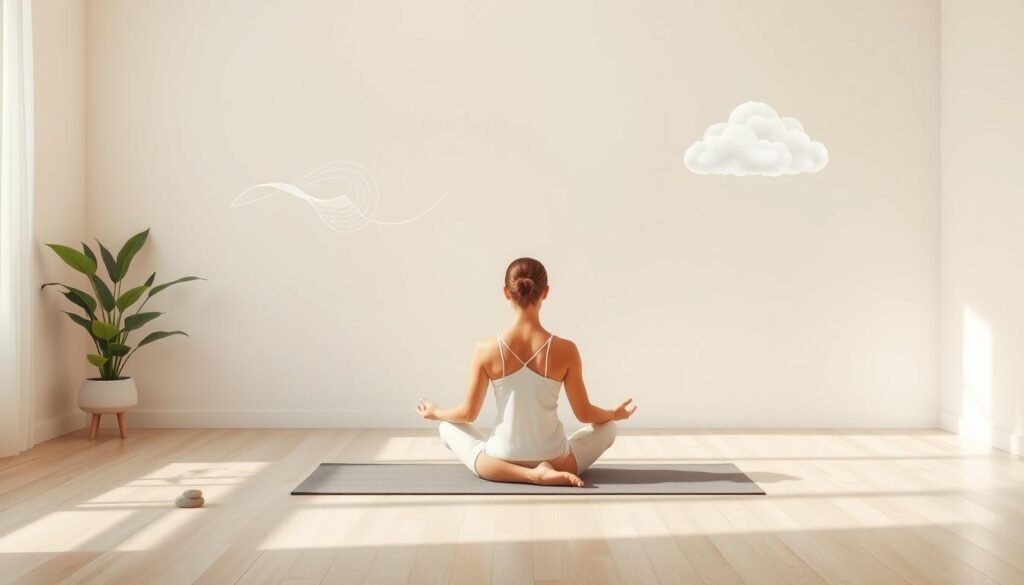Research in Frontiers in Psychology shows how diaphragmatic breathing lowers stress in healthy adults. These exercises are key for easing anxiety-induced shortness of breath. They help the body relax, improve mental clarity, and decrease panic symptoms.
By using these techniques often, people can better manage their mental health. They find peace in stressful times through regular practice.
Key Takeaways
- Breathing techniques can significantly reduce stress levels.
- Diaphragmatic breathing is beneficial for reducing negative symptoms of anxiety.
- Practicing longer exhalations helps combat the fight or flight response.
- Regular breathing exercises can enhance overall well-being.
- Incorporating these techniques into daily routines promotes holistic wellness.
Understanding Anxiety and Shortness of Breath
Anxiety affects our well-being, showing up as physical signs of anxiety. Shortness of breath is a common sign. It can cause a lot of discomfort. This problem may pop up suddenly during stressful times or when worrying.
Shortness of breath isn’t just due to one reason. It may come from health issues, allergies, or being very active. But, it’s often linked to anxiety. This link is clearer during stress, leading to fast or deep breaths.
Using special breathing techniques can help with anxiety-related breathlessness. Mindfulness and meditation are great ways to feel calm. These methods are key for handling tough symptoms. If breathlessness stays even after checking other health problems, anxiety might be the cause.
Cognitive behavioral therapy (CBT) works well for many anxiety issues, like panic and social anxiety. Talking to doctors about feeling anxious is a good step. They can suggest treatments.
Breathing Exercises to Alleviate Anxiety-Induced Shortness of Breath
Breathing methods are key for managing anxiety, especially when dealing with shortness of breath. They help by calming the nervous system and reducing stress. These techniques reverse anxiety’s typical fight-or-flight response.
Importance of Breathing Techniques
Proper breathing techniques are essential for emotional well-being. From 2904 articles, only 58 met the criteria for stress and anxiety breathing studies. Out of 72 tested methods, 54 effectively lowered stress and anxiety. This proves that effective breathing is crucial for relaxation and emotional stability.
How Anxiety Affects Breathing
Anxiety changes how we breathe, leading to more panic and breathlessness. Bad breathing habits make these problems worse. Some studies show fast breathing or short sessions don’t help much. By understanding this, people can learn exercises that restore normal breathing and manage anxiety better.
Deep Breathing Techniques for Relaxation
Taking deep breaths each day helps bring peace and calmness. It lessens stress and boosts your well-being. Trying an approach where you breathe out longer can make your body relax and ease worry.
Lengthening Your Exhale
When you breathe out longer, you can calm your mind more. It helps slow down your breathing and eases anxiety. This way, your body feels more at peace and calm. Adding relaxation exercises to your routine makes this even better. It helps you find calm moments in a busy day.
Diaphragmatic Breathing
Diaphragmatic breathing means breathing from your belly, using your diaphragm. This method makes breathing easier and better. As you get used to it, it may lower your anxiety and improve how you feel. You can try it in different ways, so anyone can do it. Regularly practicing this can help your lungs, relax you more, and keep stress away.
Mindfulness Practices for Enhanced Focus
Mindfulness can help improve focus and ease anxiety. It starts with breath focus meditation. This method makes you pay attention to how you breathe. It helps bring calmness and a clear mind. With regular practice, you’ll handle anxiety better, making these techniques very helpful.
Breath Focus Meditation
This meditation is easy yet powerful. You focus on how you breathe in and out. This helps calm your mind and decrease stress. Starting with just five deep breaths is a good beginning. Tools like the Headspace app offer help with visuals and sounds for better practice.
Guided Meditation Options
Guided meditation deepens the practice, helping with relaxation. Websites from places like the Mayo Clinic have workouts for different needs. Doing these exercises in the morning works best. It sets you up for a focused day. Daily meditation can turn it into a habit that lowers anxiety. For tips on using breathing to fight anxiety, check out this article.

Comparative Breathing Exercises
Breathing exercises help manage anxiety, offering peace and balance. They teach techniques to relax effectively. Among them, equal and resonant breathing are particularly useful. Both methods help calm the mind and body in special ways.
Equal Breathing
Equal breathing balances inhalation and exhalation times. It creates a calming rhythm. This can be very helpful for people feeling anxious. Studies show that a stable breathing pattern can ease anxiety symptoms. People doing equal breathing often feel more in control and less stressed.
Resonant Breathing
Resonant breathing means taking five full breaths per minute. This pace benefits heart rate variability and mental health. Even short sessions can lift mood and lessen stress. Thus, resonant breathing can be a key tool for overcoming emotional challenges. It often leads to better relaxation and anxiety control.
| Technique | Duration | Benefits |
|---|---|---|
| Equal Breathing | Flexible | Promotes emotional balance and relaxation |
| Resonant Breathing | 5 breaths per minute | Improves heart rate variability, enhances emotional well-being |
Trying these comparative breathing exercises can greatly aid mental health strategies. For more on breathing’s role in anxiety management, check out this research here.
Specific Techniques That Help Manage Panic Attacks
Panic attacks can make you feel lost and stressed. It’s key to have good ways to handle them. Two methods stand out for managing panic: the Lion’s Breath technique and alternate nostril breathing. These methods are great for quick relief and for getting back in control when anxiety spikes.
Lion’s Breath Technique
The Lion’s Breath technique is a special kind of breathing exercise from yoga. You take a deep breath in, then let it out forcefully, making a sound like a roar. This can help let go of stress and bring a feeling of strength and peace. Using the Lion’s Breath when panic strikes could lower anxiety a lot.
Alternate Nostril Breathing
Alternate nostril breathing is another powerful method. It’s about changing how you breathe to calm your heart and lower blood pressure. This balances your energy, lowering panic symptoms and bringing peace. People with panic issues should try this to feel calmer in tough times. For more tips, see expert advice here.

Relaxation Exercises and Stress Relief
Adding relaxation exercises to your daily routine can make a big difference in stress relief. Techniques like pursed-lip breathing and the 4-7-8 method help quiet the mind. They improve your ability to manage anxiety, leading to greater well-being.
Pursed-Lip Breathing
Pursed-lip breathing helps against rapid breathing, often seen in anxious situations. It makes you exhale longer, raising carbon dioxide in your blood. This can calm you down. By slowing your breathing, it becomes a key strategy for those feeling anxious or stressed.
4-7-8 Breathing Technique
The 4-7-8 technique is about breathing in a certain rhythm: inhale for four counts, hold for seven, then exhale for eight. It’s designed to relax you and ease anxiety. Doing it regularly can help you manage stress better. For more breathing exercises, check out this link.
Benefits of Regular Breathing Practices
Doing breathing exercises often can lead to big health perks, enhancing your overall well-being. These practices are key not just for bettering physical health but also for mental health support. By setting aside time each day for these methods, you can aim for a more balanced life.
Physical and Mental Health Improvements
Breathing workouts can lower the heart rate and better blood pressure. Diaphragmatic breathing fills the lungs fully, improving their efficiency and raising oxygen in the blood. It’s really helpful for those with conditions like COPD.
These exercises also aid muscle function in physical activities, reducing strain and promoting relaxation. The mental boosts are huge too, as they foster calm and stability feelings.
Reducing Anxiety Symptoms Over Time
Breathing exercises have a big role in lessening anxiety symptoms. The 4-7-8 method, involves inhaling for four seconds, holding for seven, then exhaling for eight, helps manage stress and promotes relaxation. With regular practice, you can manage anxiety better, leading to a stronger mind and better emotional health.
Over time, these methods become natural, letting you fight anxiety as it happens. Breathing exercises are a complete tool for a happier, anxiety-free life.

Incorporating Breathing Exercises into Daily Life
Making breathing exercises part of your everyday life can greatly improve how you handle stress. It’s good to pick certain times for these exercises. This turns them into a good habit that fits well with other ways to manage stress.
Creating a Routine
Having a set time each day for breathing exercises is key to making the most of them. You can start with 15-minute sessions. Studies show this is long enough to lower stress. Doing this daily helps make these exercises an important part of fighting anxiety.
Combining with Other Anxiety Management Techniques
Breathing exercises work great with other therapies like Cognitive Behavioral Therapy (CBT). CBT is a strong method to treat anxiety. Techniques such as 4-7-8 breathing or resonant breathing can really help. Adding things like exercise and healthy eating makes these methods even better. It creates a full plan for better mental health.
Conclusion
Breathing exercises are key for managing anxiety-induced shortness of breath, promoting overall wellness. They help people control their mental and physical health. Knowing the difference between anxiety symptoms and serious medical issues reduces worry and confusion.
Using deep breathing, mindfulness, and exercise helps with anxiety-related breathing problems. It improves mental health. When people include these practices in their daily lives, they see lasting benefits. This leads to a peaceful and balanced life.
For more details on anxiety symptoms and the value of recognizing them early, check out reliable sources. Making informed decisions and changing your lifestyle can lessen anxiety symptoms. This results in a calmer mind.